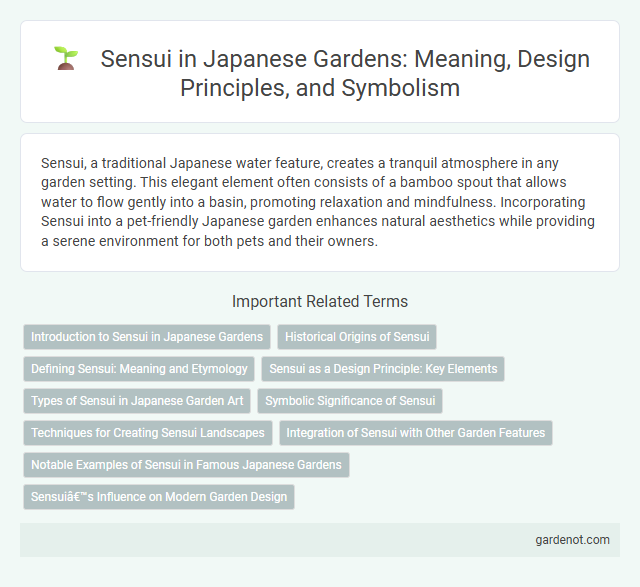Sensui, a traditional Japanese water feature, creates a tranquil atmosphere in any garden setting. This elegant element often consists of a bamboo spout that allows water to flow gently into a basin, promoting relaxation and mindfulness. Incorporating Sensui into a pet-friendly Japanese garden enhances natural aesthetics while providing a serene environment for both pets and their owners.
Introduction to Sensui in Japanese Gardens
Sensui, a traditional element in Japanese gardens, refers to carefully designed water features or streams that symbolize the flow of life and nature's tranquility. Often incorporating natural stones, gentle currents, and subtle water sounds, Sensui enhances the garden's aesthetic harmony and spiritual ambiance. This feature plays a crucial role in creating a meditative environment, reflecting the principles of balance and natural beauty central to Japanese garden design.
Historical Origins of Sensui
Sensui, also known as a traditional Japanese pond garden, originated during the Heian period (794-1185) as a central element in aristocratic landscape design, symbolizing natural beauty and spiritual harmony. These gardens were influenced by Chinese landscape aesthetics, integrating water features to represent philosophical concepts of balance and tranquility. The establishment of Sensui played a crucial role in the evolution of Japanese garden art, blending Shinto and Buddhist ideals into serene, reflective environments.
Defining Sensui: Meaning and Etymology
Sensui in Japanese gardens refers to an artificial stream or watercourse designed to mimic natural flowing water, symbolizing purification and tranquility. The term derives from the characters "sen" (Quan ), meaning spring or fountain, and "sui" (Shui ), meaning water, emphasizing its role as a water feature. Sensui serves as a crucial element in garden design, integrating the principles of harmony and natural beauty central to traditional Japanese aesthetics.
Sensui as a Design Principle: Key Elements
Sensui, a fundamental design principle in Japanese gardens, emphasizes the harmonious integration of water features to evoke tranquility and natural flow. Key elements include carefully arranged ponds, streams, and waterfalls that mimic natural landscapes, promoting reflection and serenity. This principle guides the balance between solid and void spaces, enhancing aesthetic appeal while symbolizing the continuous movement of life.
Types of Sensui in Japanese Garden Art
Sensui in Japanese garden art comprises several types, including the dry rock stream (Karesansui), characterized by carefully arranged rocks and gravel to symbolize flowing water. Another type is the pond-type sensui, featuring natural or artificial water bodies that create reflective, serene spaces integrated with plants and stones. A third form is the fountain-type sensui, often incorporating bamboo spouts and waterfalls to emphasize sound and movement within the garden.
Symbolic Significance of Sensui
Sensui, or traditional Japanese stone water basins, hold profound symbolic significance in Japanese gardens, representing purity and spiritual cleansing. Often placed near garden entrances or tea ceremony spaces, sensui invite visitors to purify their hands and mind before entering sacred or contemplative areas. The flowing water in sensui symbolizes the continuous flow of life and renewal, embodying principles of harmony and tranquility integral to Japanese garden design.
Techniques for Creating Sensui Landscapes
Sensui landscapes in Japanese gardens are crafted using precise techniques such as careful placement of rocks to mimic natural water flow and the use of shallow basins or ponds that reflect seasonal changes. Techniques include the incorporation of stepping stones and subtle water channels to create movement and rhythm, enhancing the garden's tranquility. The integration of native plants around the sensui elements further accentuates the harmony between water and landscape, embodying traditional Japanese aesthetics.
Integration of Sensui with Other Garden Features
Sensui, or traditional Japanese ponds, seamlessly integrate with garden elements such as stone lanterns, bridges, and carefully pruned trees to create a harmonious and tranquil landscape. The reflective water surfaces of Sensui enhance the aesthetic appeal of surrounding sakura blossoms and moss-covered stones, emphasizing natural beauty and seasonal changes. Strategic placement alongside gravel paths and bamboo fences enriches the sensory experience, embodying the principles of wabi-sabi and shakkei in Japanese garden design.
Notable Examples of Sensui in Famous Japanese Gardens
Sensui, or traditional Japanese dry rock waterfalls, are prominent features in renowned gardens like Ryoan-ji in Kyoto and Kenrokuen in Kanazawa, where carefully arranged stones mimic cascading water. The intricate placement of rocks in Sensui creates a dynamic sense of flow and tranquility, embodying the Zen principles central to Japanese garden aesthetics. These visual waterfalls enhance the meditative atmosphere, making Sensui an iconic element in classical Japanese landscape design.
Sensui’s Influence on Modern Garden Design
Sensui, a traditional Japanese garden style characterized by naturalistic ponds and water features, profoundly influences modern garden design by emphasizing harmony with nature and fluid spatial arrangements. Architects and landscape designers incorporate Sensui principles to create tranquil environments that balance aesthetic beauty with ecological functionality. This approach fosters sustainable garden spaces that blend seamlessly into urban settings while preserving cultural heritage.
Sensui Infographic

 gardenot.com
gardenot.com